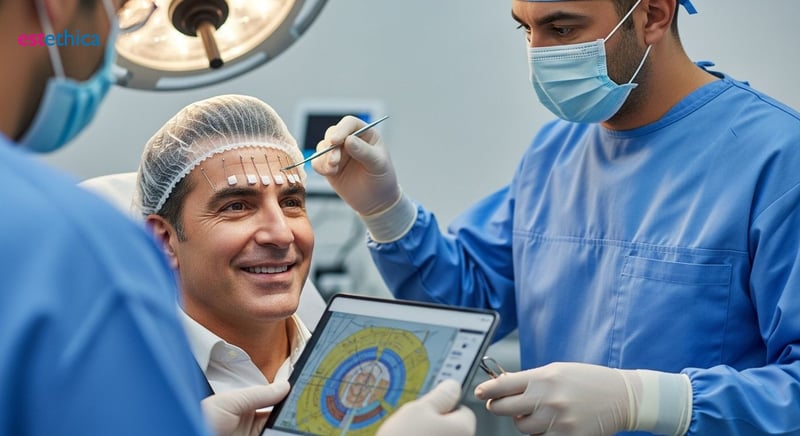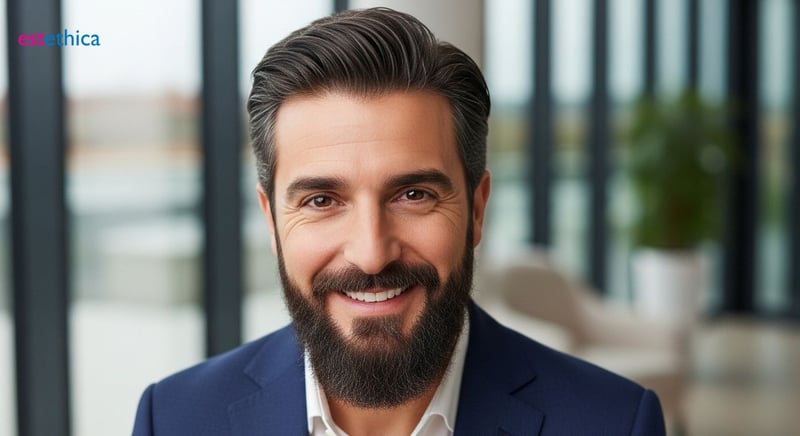Beard Transplant: Your Path to Fuller Facial Hair
Discover the transformative potential of beard transplantation for achieving a fuller, denser beard and regaining confidence. Learn about the process, results, and solutions for facial hair concerns.
Understanding Beard Transplant: How to Improve Beard Density
Achieving a denser, more uniform beard is a common aspiration for many men, and a beard transplant offers a highly effective and permanent solution. Unlike temporary cosmetic fixes, this sophisticated procedure involves carefully transplanting hair follicles from a donor area, typically the scalp, to the areas of the face where growth is sparse, patchy, or entirely absent. The key to the long-term success lies in the fact that the transplanted follicles are genetically resistant to the thinning and loss often associated with facial hair challenges. This ensures that the results are enduring.
The Transplantation Process: Precision for Natural Results
The process of how to improve beard density through transplantation is meticulous and requires significant expertise. Surgeons carefully select and harvest individual follicular units, paying close attention to matching the natural direction, angle, and thickness of the existing facial hair. This precision is crucial for creating a seamless and entirely natural-looking appearance. The number of grafts needed varies significantly depending on the desired density and the specific areas of the face requiring treatment. Several factors contribute to successful density improvement, including the surgeon's skill and experience, the quality of the donor hair available, and diligent post-operative care. Understanding the techniques employed, such as Follicular Unit Extraction (FUE) or Follicular Unit Transplantation (FUT), is fundamental to appreciating the delicate nature of this procedure. These methods are designed to minimize scarring and deliver a natural-looking outcome, effectively addressing concerns about sparse facial hair and leading to a visibly fuller beard.
What to Expect Post-Procedure
During the initial consultation phase, your surgeon will conduct a thorough assessment of your facial structure, the characteristics of your existing hair, and your specific aesthetic goals. They will then determine the optimal placement of the grafts to ensure a natural appearance that harmonizes with your unique features. Following the sakal ekimi procedure, it is normal for the transplanted hairs to shed within the first few weeks. This is a natural part of the hair growth cycle, and new growth will begin to emerge within a few months. Patience is paramount, as the full, final results of your sakal ekimi typically become apparent over a period of 12 to 18 months. Regular follow-up appointments are essential to monitor healing and allow the medical team to track the progress of your facial hair enhancement. This method represents a definitive approach to combating a thinning beard and achieving the desired volume and density.

Beard Transplant Before and After: Real Results You Can Achieve
Visualizing the potential outcome is essential when considering a beard transplant. The comparison of results offers compelling evidence of the transformative power of this procedure. Patients often experience a dramatic improvement in facial hair coverage, density, and overall appearance. Before the procedure, individuals might present with noticeable gaps in their beard, a lack of definition along the jawline, or a generally sparse look. After a successful transplant, the face appears more masculine and complete, with a naturally growing beard that fills in previously empty areas. These results are not just aesthetic; they can significantly boost self-confidence and self-esteem.
Achieving a Natural and Seamless Look
The success of a beard transplant hinges on achieving a natural look that blends seamlessly with existing hair. Skilled surgeons meticulously plan graft placement to mimic the natural growth pattern and angle of facial hair. This attention to detail is crucial for the transformation to appear genuine and for individuals seeking ways on how to improve beard density. Examining high-quality visual documentation can provide realistic expectations about the density achievable and the aesthetic harmony of the new facial hair. It's important to remember that results can vary based on individual healing and hair characteristics. Understanding the nuances of sakal ekimi is key to setting achievable goals. For those wondering how to improve beard density, a transplant offers a tangible solution.
What to Expect and Next Steps
A thorough consultation with an experienced surgeon is vital to discuss your specific needs and to view their portfolio of successful cases. This allows you to gain a clear idea of what to expect from your facial hair restoration journey. They can explain the process, from initial assessment to the final results, ensuring you feel informed and confident. The recovery period is also an important aspect to understand, as it directly impacts when you'll see the full effect of the procedure. While the initial recovery involves some minor swelling and redness, the transplanted hairs will gradually grow, leading to a fuller, more defined beard over several months. The ultimate goal is a rejuvenated appearance that enhances your natural features and boosts your overall confidence.
The Cost of a Beard Transplant: Investing in Your Confidence
When considering a beard transplant, understanding the associated financial commitment is a significant factor. The overall expense can vary widely based on several elements, including the number of grafts required, the complexity of the procedure, the clinic's location, and the surgeon's level of expertise. While it represents an investment, many individuals consider it absolutely worthwhile for the permanent boost in confidence and improved appearance it provides. Unlike temporary solutions that require ongoing effort, a beard transplant offers a long-term enhancement to your facial hair, making the initial outlay a valuable investment in your self-image and overall satisfaction.
The pricing structure typically involves a per-graft fee or a package deal based on the specific area being treated. A more extensive transplant requiring a higher number of follicular units will naturally incur a higher expenditure. It's crucial to seek clarity on precisely what is included in the quoted price. This should ideally encompass pre-operative consultations, the procedure itself, detailed post-operative care instructions, and any necessary follow-up appointments. Thorough research into the clinic's reputation and the surgeon's qualifications is just as important as understanding the financial aspect. Remember, the ultimate goal is to achieve natural-looking results and a highly satisfactory outcome. Therefore, while the financial aspect is a consideration, it should not be the sole determinant. Prioritizing quality and expertise in facial hair restoration ensures a better long-term value and a higher degree of satisfaction with your enhanced beard density.
Understanding the Factors Influencing Expense
Several key variables contribute to the final quotation for a beard transplant. The most prominent is the number of grafts needed to achieve the desired density and coverage. If you have significant thinning or empty patches, more follicular units will be transplanted, naturally increasing the overall price. The technique employed also plays a role; advanced methods might offer superior results but could have a different cost structure. Furthermore, the geographical location of the clinic can influence pricing due to varying operational costs and market demands. Highly experienced surgeons, renowned for their skill and successful outcomes, may command higher fees, reflecting their expertise and the quality of care provided.
Comparing Treatment Options
It's helpful to compare different approaches when evaluating the investment in enhanced facial hair. While a sakal ekimi is a permanent solution, it's useful to consider alternatives and their long-term implications. For those seeking to understand how to improve beard density, a surgical transplant offers a definitive answer, whereas other methods may provide temporary or less dramatic results.
For readers interested in a comprehensive overview of the procedure, consider exploring our detailed guide, Beard Transplant: Your Guide to Fuller Facial Hair.

What Causes a Patchy Beard? Facial Hair Restoration Solutions
A patchy beard can be a source of frustration for many, often stemming from a variety of underlying causes. Understanding these root issues is the crucial first step toward finding effective remedies and improving your facial hair's appearance.
Understanding the Roots of Patchiness
Genetics undeniably play a significant role, largely determining the density, thickness, and growth pattern of your facial hair from birth. Some individuals are simply predisposed to have sparser growth in certain areas. Hormonal fluctuations can also contribute; imbalances, particularly with testosterone or dihydrotestosterone (DHT) sensitivity, can impact how effectively your follicles produce hair.
Furthermore, certain medical conditions can manifest as uneven beard growth. Alopecia areata, an autoimmune disorder, can lead to localized hair loss, including on the face. Deficiencies in essential vitamins and minerals, such as biotin, zinc, or iron, can also hinder healthy hair production. Even lifestyle factors can take a toll. Chronic stress, poor nutrition lacking vital nutrients, and inadequate sleep can all indirectly affect hair health and growth cycles. Lastly, how you groom your beard matters; excessive or improper techniques can sometimes lead to breakage and thinning, exacerbating patchiness.
Effective Facial Hair Restoration Solutions
Fortunately, advancements in cosmetic procedures offer effective solutions for those struggling with a patchy beard or a generally thinning beard. For individuals seeking a permanent and natural-looking outcome, a beard transplant stands out as a leading option. This sophisticated procedure involves carefully transplanting healthy hair follicles from a donor area (typically the back or sides of the head) to the areas of your face where growth is sparse. The goal is to create a fuller, more uniform, and aesthetically pleasing beard. If you're curious about this transformative process, you might find Beard Transplant: Your Ultimate Facial Hair Restoration Journey to be an insightful read.
For those not yet considering a surgical intervention or preferring less invasive approaches, other options exist to help improve beard density. Treatments such as minoxidil (a topical solution), specialized shampoos designed to promote hair health, and targeted dietary supplements can sometimes help stimulate growth or improve the condition and thickness of existing beard hair. These can be particularly helpful when addressing minor patchiness or aiming to enhance overall beard health. If you are exploring ways on how to improve beard density, these methods are worth considering.
It is always highly recommended to consult with a dermatologist or a specialist experienced in hair restoration. They can accurately diagnose the specific cause of your patchy beard and help you develop a personalized plan. This might involve discussing options for a beard transplant, exploring medical treatments, or refining lifestyle habits to best address your unique concerns and achieve your desired beard appearance. Ultimately, finding the right approach is key to successfully enhancing your facial hair. The journey to a fuller beard often involves understanding the cause and selecting the most appropriate method, whether that's a comprehensive beard transplant or other supportive measures to improve beard density.

Advanced Beard Restoration: Precision Hair Follicle Transplantation for Denser Facial Hair
Beard transplantation, or sakal ekimi, represents a sophisticated approach to improving beard density and achieving a fuller facial hair appearance. This advanced procedure utilizes hair follicle transplantation techniques to meticulously place individual grafts, ensuring natural-looking results and a denser beard.
The process of how to improve beard density through transplantation is meticulous and requires significant expertise. It involves carefully harvesting healthy hair follicles from a donor area, typically the scalp, and expertly implanting them into areas of sparse or patchy beard growth.
Specializing in facial hair restoration, our expertise lies in understanding the nuances of different facial structures and hair types. We employ advanced beard restoration techniques to address concerns like thinning beards and what causes a patchy beard, providing permanent beard enhancement.
Our commitment is to deliver exceptional results through precise hair follicle transplantation, making us a trusted authority in men's grooming and confidence-boosting cosmetic surgery for beard enhancement.
Comprehensive Beard Transplant Process: From Consultation to Enhanced Confidence
During the initial consultation phase, your surgeon will conduct a thorough assessment of your facial structure, the characteristics of your existing hair, and your specific aesthetic goals. This personalized approach ensures the treatment plan is tailored to your unique needs for facial hair restoration.
What causes a patchy beard is carefully diagnosed to implement the most effective patchy beard solutions, offering a clear path towards achieving a denser beard. We provide comprehensive information on the beard transplant cost and the timeline of how long a beard transplant takes.
A thorough consultation with an experienced surgeon is vital to discuss your specific needs and to view their portfolio of successful cases, giving you confidence in the procedure. Our focus is on transparency regarding beard transplant cost and ensuring you are well-informed throughout the process.
We are dedicated to providing a trustworthy and expert service that delivers a significant confidence boost through permanent beard enhancement and a fuller beard.